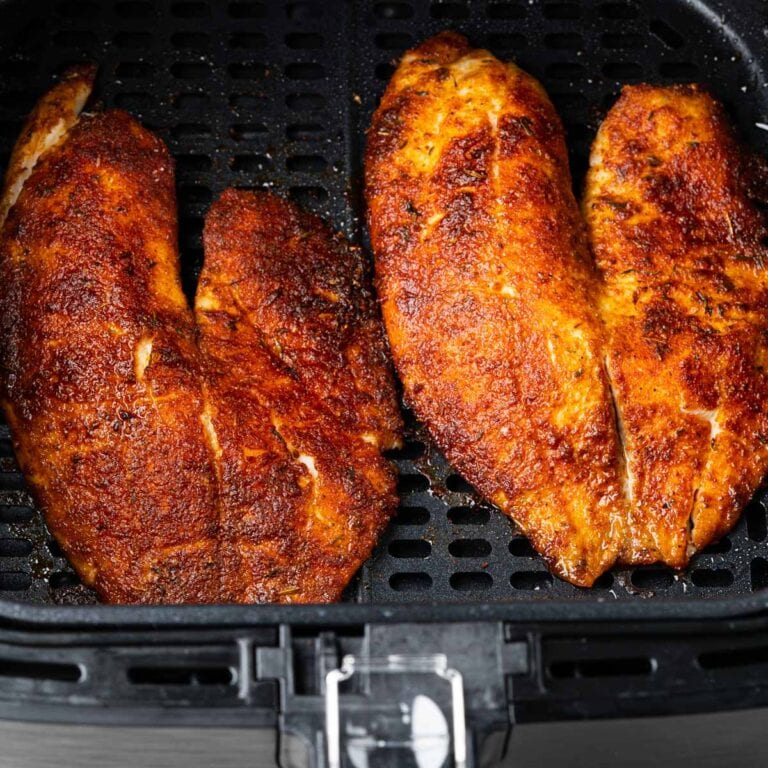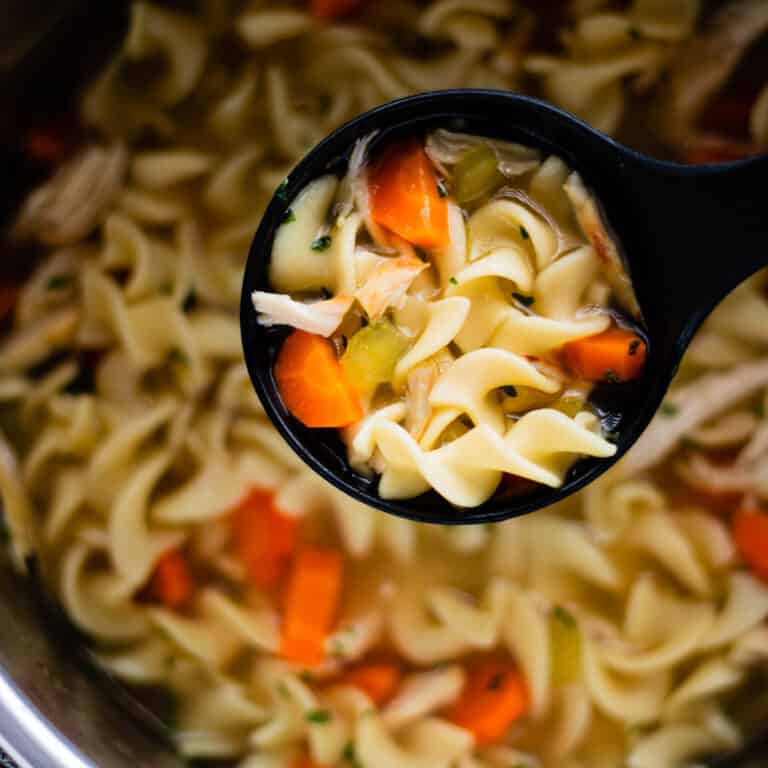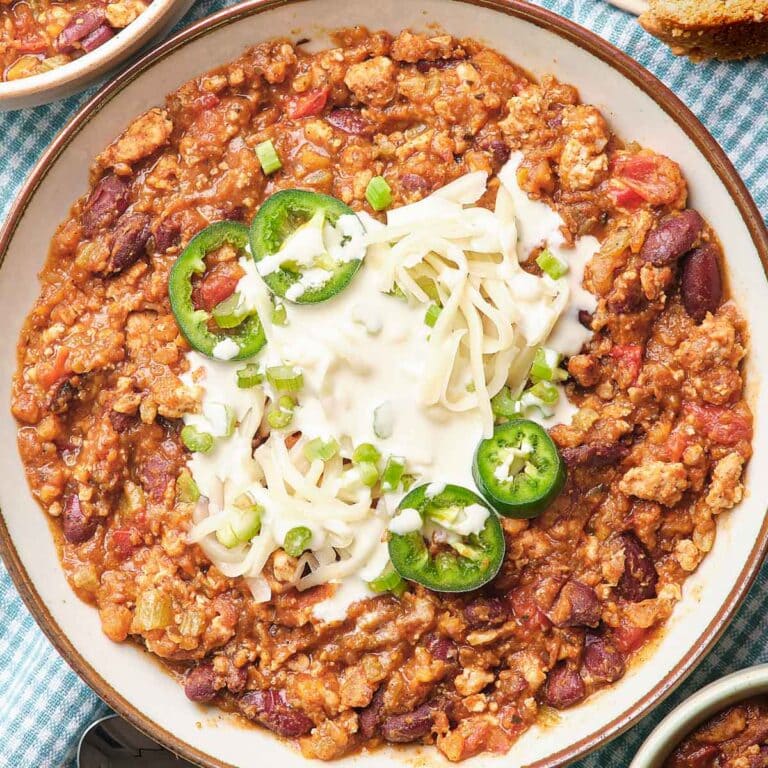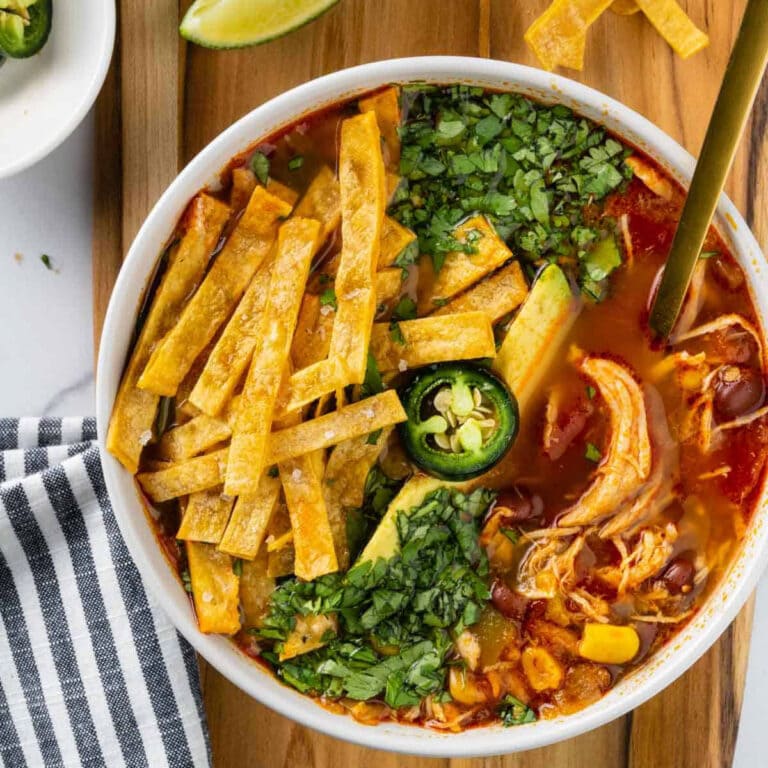Chè Chuối (Vietnamese Banana Coconut Tapioca Pudding)
Chè chuối, or banana coconut tapioca pudding, is a delightfully rich and creamy Vietnamese dessert that consists of sliced bananas and chewy tapioca pearls cooked in a pandan-infused coconut milk pudding. All you need are a few simple ingredients and 30 minutes to make this easy dessert.

What is Che Chuoi?
Che Chuoi is a popular Vietnamese dessert made with bananas, coconut milk, tapioca pearls, and various toppings. It is sweet and creamy and is often served warm. “Che” refers to a category of Vietnamese sweet soups or desserts, while “Chuoi” means bananas.
To make Che Chuoi, ripe bananas are typically sliced and cooked with coconut milk infused with fragrant pandan leaves and sugar until they soften. Tapioca pearls are added to give the dessert a chewy texture.
Che Chuoi is commonly served in bowls or glasses and garnished with toppings like roasted peanuts, sesame seeds, or coconut flakes. The warm, comforting dessert is popular as street food or as a sweet treat at home.
If you’re looking for more Vietnamese desserts, check out my che ba mau or che thai recipe.
Why You’ll Love This
- Dairy-Free Dessert: the creaminess comes from the coconut milk.
- Versatile and customizable: it allows for versatility and customization, allowing you to tailor the dessert to your liking. Adjust the amount of sugar. You can experiment with different variations and toppings to create a Che Chuoi that suits your personal taste preferences.
- Full of different textures: The softness of the bananas, the creamy coconut milk, and the chewiness of tapioca pearls create a pleasant and exciting mouthfeel. Toppings like roasted peanuts or sesame seeds add an additional crunch.
Which Type of Banana To Use
When it comes to choosing the best banana for Che Chuoi, it’s generally recommended to use ripe bananas that are sweet and soft. The choice of banana variety can vary depending on personal preference and availability. Here are a few popular banana varieties that work well for this dessert:
- Pisang Awak: This variety of bananas is often the preferred choice for making Che Chuoi. It has a sweet and creamy flavor and a soft, melt-in-your-mouth texture when cooked. Pisang Awak bananas are widely available in Southeast Asia and are commonly used in Vietnamese cuisine.
- Cavendish: Cavendish bananas are a popular and widely available variety globally. They have a mild, sweet flavor and a firm yet creamy texture. Cavendish bananas work well in Che Chuoi, providing a pleasant balance of sweetness and texture.
- Namwa: Namwa bananas, also known as Thai bananas, are suitable for Che Chuoi as well. They have a slightly tangy and fragrant taste with a creamy texture. They are often smaller in size compared to other varieties.
Ultimately, the choice of banana variety depends on personal preference and availability in your area. It’s best to choose ripe bananas that are slightly soft and have a sweet aroma. These characteristics will contribute to the overall flavor and texture of the dessert.
Ingredients and Substitutions

- Water: Used to soak the tapioca pearls and to thin out the pudding.
- Coconut cream: This is full-fat coconut milk. Choose a high-quality one, as this will be the base for the dessert and where most of the flavor will come from. Savoy, Thai Kitchen, and Native Forest are all great brands, and it is cheaper if you can find them at the store.
- Pandan leaves or clear pandan extract: Use fresh or frozen pandan leaves, which can be found at your local Asian grocery store. If you can’t find this, use clear pandan extract or vanilla extract.
- Pisang Awak bananas: Sometimes, you’ll see these labeled as Thai bananas. It is best to wait until these are ripe so they are soft and release natural sugars. If you can’t find this at the store, you can substitute it with regular bananas or ripe plantains.
- Sugar: Used to sweeten the dessert. You can adjust the amount of sugar to your desired taste.
- Salt: Used to enhance the sweetness of this dessert.
- Small tapioca pearls: These tiny tapioca pearls give the soft and creamy dessert texture and a slight chewiness.
Please scroll ⬇️ to the recipe card to see the full ingredient amounts and instructions.
Let’s Make Some Banana Tapioca Pudding!
- Add 1 cup of warm water and tapioca pearls in a small bowl. Soak for 20 minutes.
- Cut the banana into ½ inch chunks.


- In a saucepan, add 4 cups of water and bring it to a boil. Add the pandan leaves and let it simmer for 8-10 minutes. Then, remove the pandan leaves and discard them.


- Drain the tapioca pearls and add them to the pot. Give them a quick stir to separate them and prevent them from sticking to the bottom of the pot.
- Next, add bananas, sugar, coconut cream, and salt. Gently stir and let it simmer for about 5-6 minutes or until the bananas and pearls are softened. Do a taste test and add more sugar, if desired.


- Add roast crushed peanuts and sesame seeds, as desired. Serve warm or cold.

Tips for Success
– Choose ripe but firm bananas: Select bananas that are ripe and flavorful, but still firm enough to hold their shape during cooking. Overly ripe bananas may become mushy and disintegrate in the dessert.
– Soak tapioca pearls adequately: If you’re using tapioca pearls, ensure you soak them for the recommended time to soften them properly. Follow the package instructions for soaking time, as it may vary depending on the size and type of tapioca pearls you’re using.
– Adjust sweetness to taste: Taste the Che Chuoi as you cook and adjust the sweetness according to your preference. Add sugar gradually, allowing it to dissolve and blend into the dessert. Remember that the sweetness of bananas can vary, so the amount of sugar needed may differ.
– Use good-quality coconut milk: Opt for high-quality coconut milk, as it contributes to the creaminess and flavor of the dessert. If possible, choose high-fat coconut milk (coconut cream) with a high coconut content.
– Cook bananas gently: Cook the bananas over medium heat to ensure they soften and infuse with the coconut milk without becoming mushy. Stir gently to avoid breaking up the banana slices.
– Experiment with toppings: While Che Chuoi is delicious on its own, adding toppings can enhance the flavor and provide textural contrast. Consider garnishing with roasted peanuts, sesame seeds, or coconut flakes for added crunch and visual appeal.
Frequently Asked Questions

Yes, you can definitely use plantains for Che Chuoi. Plantains are a slightly different variety of banana, known for their starchy texture and versatility in cooking. While traditional Che Chuoi typically uses regular bananas, using plantains can add a unique twist to the dessert. When using plantains, it’s best to select ripe plantains that are still firm.
If your Che Chuoi has become too thick and you would like to thin it out to adjust the consistency, here’s what you can do:
1. Add more liquid: The easiest way to thin out Che Chuoi is to add more liquid, typically coconut milk or water. Start by adding a small amount at a time, about a tablespoon or two, and stir well to incorporate it into the dessert. Continue adding liquid gradually until you reach the desired consistency. Be careful not to add too much liquid at once, as it can make the dessert too watery.
2. Heat and stir: If you prefer a thinner consistency, you can gently heat the Che Chuoi on the stovetop over low heat while stirring continuously. The heat will help loosen the mixture and make it more liquid. Again, add small amounts of liquid if needed while stirring until you achieve the desired consistency.
3. Adjust tapioca pearls: If your Che Chuoi has become thick due to the tapioca pearls absorbing too much liquid, you can try adjusting the amount of tapioca pearls in the recipe. You can either reduce the amount of tapioca pearls used or increase the amount of liquid to balance out their absorption.
Remember to taste and adjust the sweetness and flavors as you thin out the Che Chuoi. You can add more sugar if needed to maintain the desired level of sweetness.
If your Che Chuoi is too thin and you would like to thicken it, here are some methods you can try:
1. Cook it longer: One of the simplest ways to thicken Che Chuoi is to continue cooking it over low heat. The prolonged cooking time allows for evaporation, resulting in a thicker consistency. Keep stirring the mixture regularly to prevent it from sticking to the bottom of the pot.
2. Increase the heat: If you’re in a hurry to thicken the Che Chuoi, you can slightly increase the heat to medium-low while stirring continuously. This will help speed up the evaporation process and thicken the dessert more quickly. Just be cautious not to scorch the bottom of the pot, so keep stirring consistently.
3. Add tapioca flour/starch slurry: Prepare a slurry by mixing tapioca flour or starch with a small amount of water or coconut milk to create a smooth paste. Gradually add the slurry to the Che Chuoi while stirring continuously. The tapioca flour/starch will act as a thickening agent, helping to thicken the mixture. Allow it to cook for a few more minutes to activate the thickening properties.
4. Let it cool and refrigerate: In some cases, Che Chuoi may naturally thicken as it cools. If you prefer a thicker consistency, allow the Che Chuoi to cool down and then refrigerate it. The cooling process can cause the dessert to set and become thicker. However, note that this method may not result in a significant thickening effect.
Remember, it’s important to make adjustments gradually and to keep the desired consistency in mind. You can combine different methods to achieve the desired thickness. However, be cautious not to over-thicken the Che Chuoi, as it can become too dense or lose its creamy texture.
How to Store Leftovers
Refrigerate
Allow the Che Chuoi to cool down to room temperature before storing. This helps prevent condensation and maintains the quality of the dessert. Transfer the leftovers to an airtight container or a sealable bag. Place the container in the refrigerator. Che Chuoi can be stored in the refrigerator for up to 3-4 days.
Reheat
When you’re ready to enjoy the leftover Che Chuoi, gently reheat it on the stovetop over low heat. Stir occasionally to ensure even warming. Alternatively, you can microwave individual portions on low power until warm.
Note: The texture of the bananas and tapioca pearls may change slightly after refrigeration. The dessert might become thicker, or the tapioca pearls may absorb more liquid. If it becomes too thick, you can add a little warm coconut milk or water to adjust the consistency.
Freeze
Leftover Che Chuoi should be consumed within a few days to ensure freshness and quality. If you have a large amount of banana pudding and don’t think you’ll be able to finish it within a few days, you can also consider freezing individual portions in airtight containers or freezer-safe bags. Thaw the frozen banana pudding in the refrigerator overnight and gently reheat before serving.
RECIPE

Chè Chuối (Vietnamese Banana Coconut Tapioca Pudding)
Ingredients
- 2 ½ cups water
- 1 (13.5 oz) can coconut cream
- 3 pandan leaves, rinsed and tied into knots, or ½ teaspoon clear pandan extract
- 1½ pounds pisang awak bananas or plantains (about 8 small bananas)
- 3 tablespoons sugar
- ¼ teaspoon salt
- ⅓ cup small tapioca pearls
Toppings
- roasted peanuts, roughly crushed
- roasted sesame seeds
Instructions
- Add 1 cup of warm water and tapioca pearls to a small bowl. Soak for 20 minutes.
- Cut the banana into ½ inch chunks.
- In a saucepan, add 4 cups of water and bring it to a boil. Add the pandan leaves and let it simmer for 8-10 minutes. Then, remove the pandan leaves and discard them.
- Drain the tapioca pearls and add it to the pot. Give it a quick stir to separate and prevent it from sticking to the bottom of the pot.
- Next, add bananas, sugar, coconut cream, and salt. Gently stir and let it simmer for about 5-6 minutes, or until the banana and pearls are softened.
- Add roast crushed peanuts and sesame seeds, as desired. Serve warm or cold.
Notes
-
- Choose ripe but firm bananas: Select bananas that are ripe and flavorful but still firm enough to hold their shape during cooking. Overly ripe bananas may become mushy and disintegrate in the dessert.
-
- Soak tapioca pearls adequately: If you’re using tapioca pearls, ensure you soak them for the recommended time to soften them properly. Follow the package instructions for soaking time, as it may vary depending on the size and type of tapioca pearls you’re using.
-
- Adjust sweetness to taste: Taste the Che Chuoi as you cook and adjust the sweetness according to your preference. Add sugar gradually, allowing it to dissolve and blend into the dessert. Remember that the sweetness of bananas can vary, so the amount of sugar needed may differ.
-
- Use good-quality coconut milk: Opt for high-quality coconut milk, as it contributes to the creaminess and flavor of the dessert. If possible, choose high-fat coconut milk (coconut cream) with a high coconut content.
-
- Cook bananas gently: Cook the bananas over medium heat to ensure they soften and infuse with the coconut milk without becoming mushy. Stir gently to avoid breaking up the banana slices.
-
- Experiment with toppings: While Che Chuoi is delicious on its own, adding toppings can enhance the flavor and provide textural contrast. Consider garnishing with roasted peanuts, sesame seeds, or coconut flakes for added crunch and visual appeal.







My dad grew up eating this pudding and I was thrilled to be able to make it for him. He loved it.
Super delicious! I made it over the weekend it was great warm or cold. Great for a rainy day!
Love the flavor and texture of this. Thank you.
That looks so good and I love a banana dessert. Can’t wait to try it.
My favorite Vietnamese dessert. I love how smooth and tasty this dessert is.
I love anything with coconut and this was amazing. So easy to make too.
What a lovely recipe! I had so much fun making it and it turned out REALLY good. Super happy with this one.
I love bananas – a great bowl of deliciousness.
So delicious and refreshing!
This banana tapioca pudding sounds delicious!